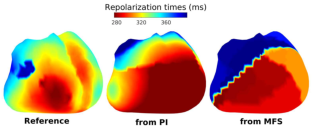Section: New Results
A parameter optimization method to solve the ECG inverse problem
Existing electrocardiographic inverse models express their results either in terms of potentials on the heart surface or in terms of activation times in the heart. G. Ravon developed a new method which gives a potentially more useful answer in terms of three parameters of the underlying action potentials in the heart [27]. Since there are more parameters, care had to be taken to avoid overfitting. Tests on in-silico and ex-vivo data showed good results: the method gave better activation maps than the method of fundamental solutions to which it was compared, and fitted the repolarization phase of the ECG accurately. Figure shows an example of an inversely estimated repolarization map.



